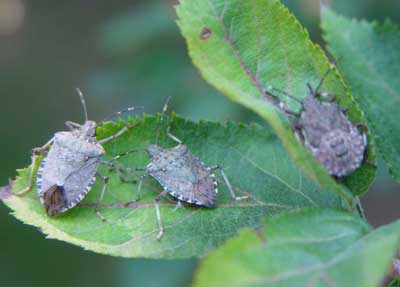- Brown marmorated stink bug
Taxobox | name = Brown marmorated stink bug

image_width = 200px
image_caption = Adults
regnum =Animal ia
phylum =Arthropod a
classis =Insect a
ordo =Hemiptera
familia =Pentatomidae
genus = "Halyomorpha "
species = "H. halys"
binomial = "Halyomorpha halys"
binomial_authority = Stål"Halyomorpha halys", the brown marmorated stink bug, is believed to have "hitched a ride" as a stowaway in
packing crate s fromAsia ; it was accidentally introduced into theUnited States fromChina orJapan . The first documented specimen was collected inAllentown, Pennsylvania , during the fall of 1996. In 1999, the brown marmorated stink bug was first recovered inNew Jersey from ablack light trap run by the Rutgers Cooperative Extension (RCE) Vegetable IPM program inMilford, New Jersey [cite web |url=http://www.rce.rutgers.edu/stinkbug/ |title=Monitoring for the Brown Marmorated Stink Bug |publisher=Rutgers, The State University of New Jersey ] . In 2002, it was again collected from black light traps located in Phillipsburg and Little York and found on plant material in Stewartsville. It is now documented and established in many counties in the tri-state area (New Jersey,Pennsylvania andNew York ) on the eastern coast of the United States. This agricultural pest has already reachedMaryland andWest Virginia , and studies continue to establish just how extensive the infestation may go.It looks similar in appearance to other native species of
shield bug s including "Acrosternum ", "Euschistus ", and "Podisus ", except that several of the abdominal segments protrude from beneath the wings and are alternatively banded with black and white (visible along the edge of the bug even when wings are folded) and a white stripe or band on the next to last (4th) antennal segment. The adults are approximately ⅝ inch long and the underside is white or pale tan, sometimes with grey or black markings. The legs are brown with faint white banding.It is an
agricultural pest that can cause widespread damage to fruit and vegetable crops. In Japan it is a pest tosoybean and fruit crops. In the U.S., the brown marmorated stink bug feeds on a wide range of fruits, vegetables, and other host plants beginning in late May/early June including peaches, apples, green beans, soybeans, cherry, raspberries, and pears. It is a sucking insect that uses its proboscis to pierce the host plant in order to feed. This feeding results, in part, in the formation of small, necrotic areas on the outer surface of fruits but ranges from leaf stippling, cat-facing on tree fruits, seed loss, and transmission of plant pathogens.The brown marmorated stink bug survives the winter as adults by entering houses and structures when fall evenings start to turn cold. Adults can live for several years and look for buildings to overwinter in that shield them from the elements. They will work their way under siding, into soffits, around window and door frames, under roof shingles and into any crawl space or attic vent which has openings big enough to fit through. Once inside the home they will go into a state of hibernation where they wait for winter to pass, but often the warmth inside the home causes them to become active, especially in winter months, and they will fly clumsily around light fixtures. They leave a powerful scent behind on everything they land on, including the buildings where they hibernate, and this odor is one of the reasons they will return year after year; it is a beacon to other stinkbugs that this location is a good hibernation nest.
The stinkbug's ability to emit a vile odor through holes in its abdomen is a defense mechanism meant to prevent it from being eaten by birds and lizards. However, simply jostling the bug, cornering it, scaring or injuring it, or attempting to remove one from one's home can "set it off," and the odor is extremely powerful, unpleasant, and long-lasting. It can make a whole room uninhabitable until aired out, and some people are even allergic to the smell. Squashing it is a surefire way of expelling its noxious odor, and most times the best way of extracting one from the inside of a home is to allow it to walk onto something like a newspaper and then simply taking it outside. Another option is to gently collect it using a piece of tissue and flushing it. One other way of disposal is killing it with an electric flyswatter. This kills them almost instantly without squashing them. The stink glands are located on the underside of the thorax, between the first and second pair of legs, if squeezed the vile odor will remain on your hands for awhile.
References
External Links
* [http://creatures.ifas.ufl.edu/beneficial/a_grandis.htm brown marmorated stink bug] on the
UF / IFAS Featured Creatures Web site
Wikimedia Foundation. 2010.
